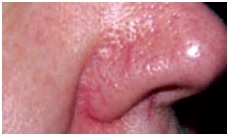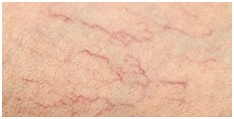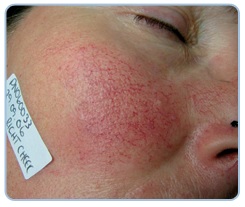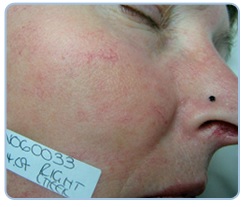Portfolio Description
Advanced Electrolysis & Skin Tag Removal
Skin Treatment
Advanced Electrolysis & Skin Tag Removal
Skin Treatment
It is a new name for ‘Advanced Electrolysis’ plus all the new additional techniques. This speciality treatment uses either Short Wave Diathermy (High Frequency A/C) or Blend (a mixture of A/C and D/C) to remove unwanted skin blemishes with no mark left on the skin.
Did you know that most skin blemishes can be permanently removed with just one 15-minute treatment? Many people are not aware of this, simply accepting their skin problem without seeking treatment, believing they have no other choice.
We often spot blemishes when our clients are undergoing laser hair removal or other treatments. When we point out the blemishes, they are surprised that we can remove them permanently with only one 15-minute treatment.
Skin tags are small flesh-coloured or brown growths that hang off the skin and look a bit like warts. They are very common and harmless.
Skin tags are usually a few millimetres in size, although can be as big as 5cm.
They are usually found on the neck, in the armpits, around the groin, or under the breasts. They can also grow on the eyelids or under the folds of the buttocks.
Why skin tags occur
Anyone can develop skin tags, Some people develop them for no apparent reason.
It is thought skin tags grow where skin rubs against skin or clothing. This would explain why they tend to affect overweight people who have excess folds of skin and skin chafing.
When skin tags can be a problem
Skin tags are harmless and do not usually cause pain or discomfort.
However, you may want to consider getting them removed if they are unsightly and affect your self-esteem, or if they snag on clothing or jewellery and bleed we can help by removing this skin tags for free consultation please call as at Visage Dermalogical Clinic.


Dermatosis Papulosa Nigra is a skin condition that appears as a multitude of dark coloured, benign growths which occur frequently in people of African American origin. It is easy to recognize a dermatosis papulosa nigra skin condition after the multiple, small, hyperpigmented and asymptomatic papules on the face of African and the fitzpatric 4 skin type people mainly.
DPN is also known to resemble the seborrheic keratoses, another type of benign skin condition that causes cosmetic problems.
In our clinic we can treat with laser the red spider veins that appear on the face and body
In the past, for the treatment of this problem we used electrolysis, a method which brought unbearable pain and sometimes scars but nowadays, we most commonly use the Nd:Yag laser whose discomfort sensation is minimal.
Spider veins are little red, blue or purple blood veins, which appear especially on the face, near the eyes and nose area. Some of the causes of these red spider veins are due to prolonged exposure to sunlight, ageing, trauma and alcoholic liver disease.
Before starting a Nd:Yag laser treatment you will get a full specialty assessment. This procedure is necessary in order to identify the type and stringency of the affliction, the sensitivity of the skin and to know all the medical history, for the maximum safety of our clients. After identifying the problem area, the blood vessels that are to be treated are examined, starting with the large ones and finishing with the thin and less affected ones.
Regardless of the cause of their appearance, the Nd:Yag laser is used as a cosmetic treatment.
Because of the advanced Nd:Yag laser treatment, it gives an accurate distribution of the laser’s energy along the blood veins, leading to their coagulation, followed by their absorption by the body. In some cases, bruising may appear in the treated areas, which will disappear without problems in a week at most. After the treatment ,we recommend the avoidance of hot baths, sun exposure and high effort exercise on the day. The number of laser sessions is established according to the size of the affliction but for the best results it may be necessary for more than one intervention. Nd:Yag Laser’s utility finds its application on all skin types, with best results.
The painless and efficient method of laser therapy is applicable on both men and women for solving the unaesthetic aspect of the spider veins. More than that, the persons undergoing this kind of treatment can resume their daily activities right after the intervention, without needing any restrictions.

Spider Veins
Small blood vessels that become enlarged near the surface of the skin and appear as blue, purple, or red thread-like lines.
A spider angioma (also known as a nevus araneus, spider nevus, vascular spider, and spider telangiectasia[1]) is a type of telangiectasis[2] (swollen blood vessels) found slightly beneath the skin surface, often containing a central red spot and reddish extensions which radiate outwards like a spider’s web can be treated with electrolysis or our ND YAG laser – Campbell De Morgan
 Campbell De Morgan
Campbell De Morgan
These are common, benign skin lesions of middle to older age, formed by proliferating, dilated capillaries and postcapillary venules.can be treated with our ND YAG laser please call for consolation
Thread Veins
Thread veins are also very common. They are mainly found around the nose and in the legs, often on the sides of the knee area. Thread veins are caused by numerous factors such as pregnancy, smoking, hormones, and ageing. The needle is put on to the vein and then an electrical current is released. The current will cauterize the vein, killing the vessel wall and causing the blood to coagulate to the surface and then disappear.This procedure is usually permanent.
Intense Pulsed Light (IPL) can give a long term solution to red veins in just a few fast and easy treatments. Unlike some other treatments, there is ‘no downtime’ in as much as you can have a treatment and then return to work afterwards
Not all IPL Treatments are the same
 For the best and most effective treatments, a specialist clinic with experienced staff is essential
For the best and most effective treatments, a specialist clinic with experienced staff is essential
Following deregulation anyone can now buy and use this equipment, The PulseLight Equipment is safe and clinically proven to give fast and effective results.
How does it work?
It emits specific pulses and frequencies of light that are specific to the red veins they are targeting.
This is a reason why experience is essential. The optimum settings are often a matter of experience and judgement
 Types of veins that can be treated
Types of veins that can be treated
The treatment is effective for a spectrum of blood vessels related conditions and treats facial thread veins, rosacea, spider veins, and even port wine stains.
How is the treatment effected?
A smooth gel is applied to the area to be treated and then the IPL applicator is placed on the skin and a short pulses of light are released. The applicator is moved slightly and the whole of the affected area is treated.
Am I suitable for treatment?
Simply use our contact form and possibly upload a photo for a fast response. You can
How long does each treatment take?
Typically from 15 to 45 minutes per session.
How many sessions are needed?
Typically 3 to 5 treatments give the best possible results, although small red veins may be cleared in just one single session.
 Seborrheic keratoses are noncancerous (benign) skin growths that some people develop as they age. They often appear on the back or chest, but can occur on any part of the body. Seborrheic keratoses grow slowly, in groups or singly. Most people will develop at least one seborrheic keratosis during their lifetime.
Seborrheic keratoses are noncancerous (benign) skin growths that some people develop as they age. They often appear on the back or chest, but can occur on any part of the body. Seborrheic keratoses grow slowly, in groups or singly. Most people will develop at least one seborrheic keratosis during their lifetime.
The appearance of seborrheic keratoses can vary widely. They may be light tan to brown or black. The most common texture is rough, with a bumpy, grainy surface that crumbles easily. However, they also may be smooth and waxy. They usually look like they’ve been stuck onto the skin. While some are tiny, others grow larger than 3 cm in diameter.
Seborrheic keratoses may be mistaken for warts, moles, skin tags, or skin cancer.
 What are milia and what do they look like?
What are milia and what do they look like?
Small cysts usually found around the eyes and on the cheekbones.
A milium is a small, raised bump on the skin. It is a type of tiny skin cyst filled with a protein called keratin.
Many are usually found together and so they are called milia (the plural of milium).
As can be seen in the picture, milia are usually each about 1 or 2 millimeter across and are pearly-white or yellowish.
They are most often seen on the skin around the cheeks, nose, eyes and eyelids, forehead and chest but they can occur anywhere on the body.
we will recommend our Oxygen treatment for multiple milia condition.
 Round, hard, rough growths caused by a virus known as HPV infecting the top layer of skin.
Round, hard, rough growths caused by a virus known as HPV infecting the top layer of skin.
What are warts?
Warts are small, skin-coloured, rough excess growths of skin. They can be as small as 1mm or as big as 1cm in diameter, and can occur on their own or in clusters.
Common warts are the most frequently occurring type of wart (70% of all warts are common warts). The common wart is easily recognisable by the rough ‘cauliflower-like’ appearance of its surface. They can appear anywhere on the body, but they’re most common on knuckles, knees and fingers. We’re prone to getting a wart if the skin on our feet is damaged by cuts or scratches and comes into contact with rough surfaces contaminated with the virus.
What causes warts?
Warts are caused by a virus, the Human Papilloma Virus (HPV), which enters the skin through small cuts and scratches. Warts do not appear immediately following infection – the incubation periods can be as long as 24 months.
Things to know about warts.
If untreated, trouble-free warts will often disappear in time. But it’s important to remember that they will remain contagious and may spread elsewhere if left untreated.
Children are particularly susceptible.
Warts are very common in young children, and there is a natural tendency for them to pick or scratch existing warts. This releases the virus, spreading them to unaffected skin and other people through physical contact.
It is estimated that at any time, around one in ten people in the UK have a verruca or wart.
please call as for consultation we treat warts is several ways .
1. prescriptive herbal medication
2. advance electrolysis,
TREATMENT OVERVIEW
Condition treated
for all skin type use as first time assessment
Procedure time
15 minute
Practitioner
Aesthetic Practitioner
Price
call for details
Clinic Papers
Click to view
Required Treatments
to be decided on the initial consultation
Contraindication
View list
Visit our clinic
72 The Broadway
Stanmore HA7 4DU
view map and directions
Call us
020 8954 0035
Email us
sales@visagedermalogical.com














